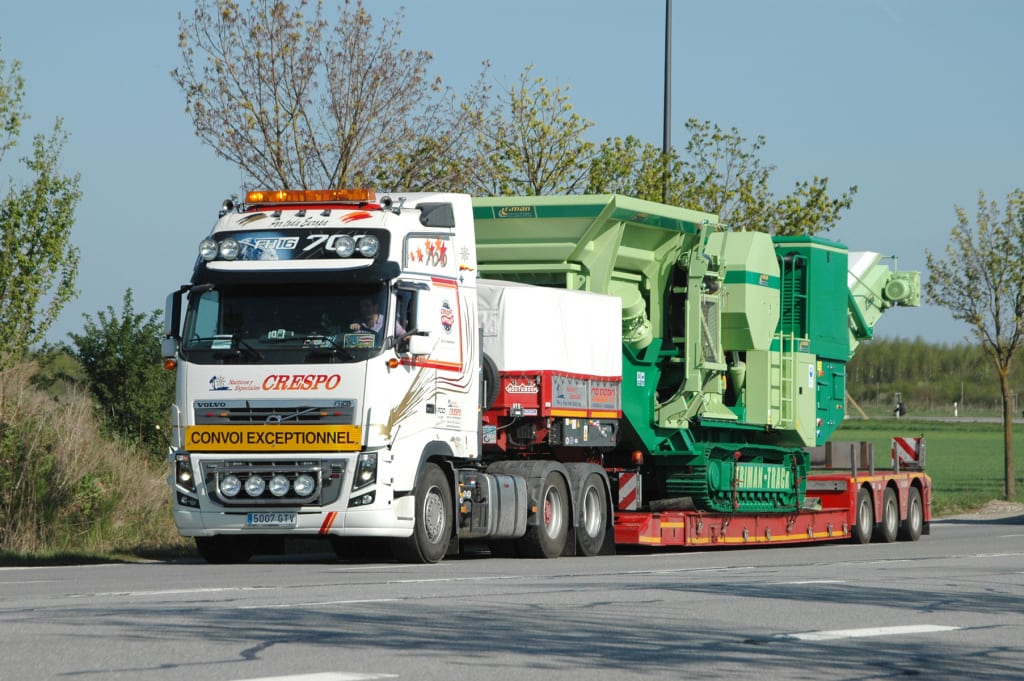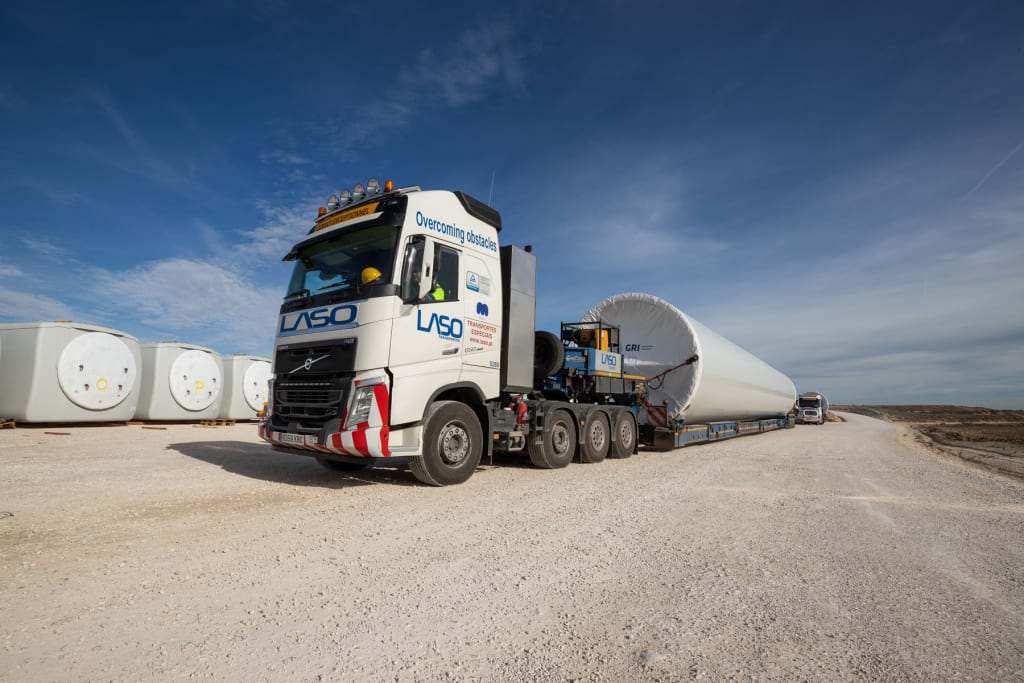Last update: 03-2019
Rules and Regulations in Spain
 The regulations regarding exemption applications for a special transport vary widely in the member states of the European Union. In spite of the efforts of ESTA and various other organisations – they would like to see one single European exemption system – this situation is not going to change in the next few years. In Spain the general guidelines for exemptions are fairly straightforward, but the system also contains numerous exceptions.
The regulations regarding exemption applications for a special transport vary widely in the member states of the European Union. In spite of the efforts of ESTA and various other organisations – they would like to see one single European exemption system – this situation is not going to change in the next few years. In Spain the general guidelines for exemptions are fairly straightforward, but the system also contains numerous exceptions.
Years ago ESTA submitted a proposal for a simplified exemption system within Europe. This proposal was not even taken into consideration in the EU, for at least four reasons. The main reason is that abnormal transport is by definition ‘non-statutory’. In every EU member state one – or sometimes even more than one – organisation is given the mandate to issue exemptions for vehicles that exceed the maximum legal dimensions and weight. These regulations often differ per region or province. The second reason is the variety of local conditions that prevail in Europe. Wide motorways require a different policy than narrow mountain roads. And if we consider the various load capacities and maximum height for bridges and viaducts as well as totally different weather conditions, it is clear that the regulations are adapted to local conditions. The third reason lies in the past. Between 1960 and 1970 the first heavy and large transports appeared on the roads.
Usually the police – in consultation with the road authority – decided whether a route was suitable. This created considerable variations per municipality and region. The European roads are administered by thousands of different road authorities who all have their own opinion about their little piece of the road network. The final reason: in most European countries a local transport operator will have an advantage when applying for an exemption. This may evoke negative, nationalist feelings but in most cases this is not justified. A local transport operator is best placed to judge the situation on the road in his own country. And of course he can communicate in his own language with the agencies who issue the exemptions.
The Direccion General de Transportes, Permisos Especiales department, in Madrid, is responsible for issuing exemptions in Spain. The regulations – on the whole – are straightforward: three kinds of vehicles, three categories and three regions. It will come as no surprise that this classification has a number of exceptions.
For exemption applications a distinction is made between four different groups of vehicles. The fourth group represents vehicles that don’t belong in the first three groups. For example: a small tourist train to transport people over the road. We will ignore this group. In the first group are vehicles for indivisible loads. In the second group are agricultural machinery and in the third group are the ‘exceptional’ vehicles for public works and public authorities. The vehicles of transport operators always fall within group 1 (indivisible loads).
Exemptions are granted in three categories: Genérica, Específica and Excepcional. The Category Genérica includes transports up to 20.55m long, 3m wide and 4.50m high. The total mass of the vehicle must not exceed 45 tonnes. These transports may be carried out during the day as well as at night and for a ‘Genérica’ transport no escort is needed. The category ‘Específica’ includes transports up to 40m long, 5m wide and higher than 4.7m. The maximum gross weight for the ‘Específica’ category is 110 tonnes. Exemptions for this category are issued for a specific route. The validity varies per region. The top class is ‘Excepcional’. These are all transports that exceed the permitted dimensions and weight in the ‘Específica’ category. In practice these are the really large and heavy transports for which the route has to be assessed on a case by case basis. NB: these dimensions and weights only apply to the vehicle groups 1 and 3. For group 2 (agricultural machinery) there is no ‘Excepcional’ category. Another important point: if the load protrudes more than 3 metres from the rear of the vehicle it has to be explained by means of drawings, photographs or calculations why this large overhang is necessary.
For the application of exemptions there are three different regions in Spain: the Basque country, Navarre and the rest of Spain including Catalonia. In principle it is one system but with considerable differences in the details, such as the period of validity, the number of trailers included in the exemption and deposits for heavy transports. Within the regional areas there are exceptions too. For instance, in the port of Barcelona they provide an admission pass only on presentation of an exemption.
In Spain there are numerous driving bans on national and regional holidays. It is important to take note of the times because they vary. For abnormal transports there is a driving ban from Saturday or the day before a national holiday from 13.00 hrs to 02.00 hrs on Monday (or the day after the holiday). For a regional holiday the driving ban starts at 0.00 hrs and lasts until 02.00 hrs on the day after the holiday. In the Basque country it is different: the driving ban there starts on Saturday (or the day before a holiday) from 13.00 hrs to Sunday 24.00 hrs. There is also a driving ban on 31 July from 08.00 hrs to 24.00 hrs.
The procedure to apply for exemptions in Spain is not complicated as long as it doesn’t concern transport in the ‘Excepcional’ category. Prior to applying for an exemption the transport company and their equipment must be registered. This can only be done with documents that have been translated by a translator who is recognised in Spain. In the Basque country and Navarre a copy of the translated documents with the application is sufficient. For the rest of Spain the original documents must be supplied with the application. This registration is a one-off. When this has been completed a standard application will be dealt with quite quickly. Most exemptions (except in the ‘Excepcional’ category) are issued within a week. Note that the special exemption for the port of Barcelona can take longer. If prepared properly the entire procedure in Spain runs quite smoothly.
With large, heavy transports there is a real risk of damaging the road, bridges or buildings. To ensure that any damage will be compensated, a deposit has to be paid in the ‘Excepcionel’ category. This deposit may be as much as € 6,000 per trip in one region. And don’t expect an employee of the region to go and check the day after the transport to see if any damage has been done. Reports of damage can still come in after months. That’s why it can take up to a year before the deposit is paid back into the company’s bank account.
Exemptions in the category ‘Genérica’ (up to 20.55m long and 3m wide) are applicable in the whole of Spain. This long-term exemption does not apply to all the roads. Some roads – such as a number of toll roads – are not owned by the government. For those roads a separate exemption must be applied for. In practice most people will look for alternative routes, so that it won’t be necessary to apply for several exemptions for one single transport.
The costs of an exemption in Spain are about average compared with other countries in Europe. Not exactly cheap but not too expensive either. The costs comprise different amounts for the Basque country, Navarre and the rest of Spain plus an amount depending on the number of trailers on the exemption. For an expert it is not difficult to more or less accurately calculate the costs of a Spanish exemption beforehand.
In Spain abnormal transports are regularly checked. Minor infringements are usually settled with a fine if the correct exemption can be produced. If the weight is too high it is more severely penalized than a few centimetres too high or too wide. After a check the transport can nearly always continue on its way. Only in exceptional situations will you be asked to transfer the load to another vehicle.
For normal transports in the ‘Específica’ category private escorts may be used. ‘Excepcional’ transports are usually escorted by the police department ATGC (Agrupación de Tráfico de la Guardia Civil). It’s possible to drive in convoy with some special transport vehicles.
For normal transports in the ‘Específica’ category private escorts may be used. ‘Excepcional’ transports are usually escorted by the police department ATGC (Agrupación de Tráfico de la Guardia Civil). It’s possible to drive in convoy with some special transport vehicles.








